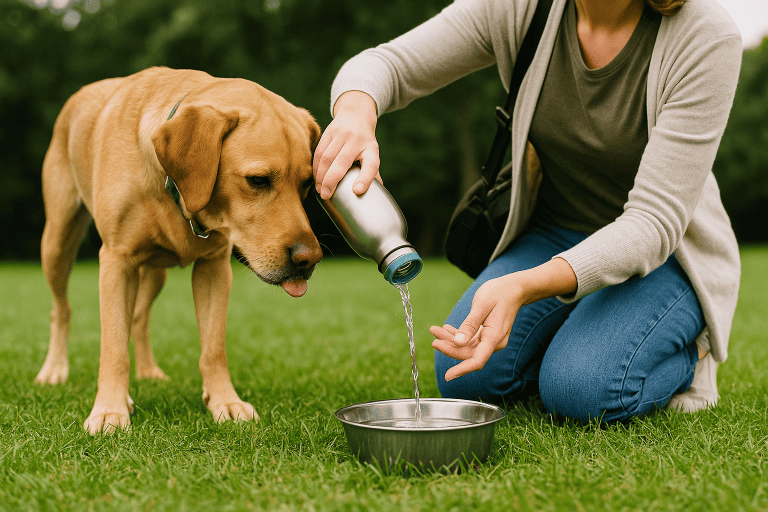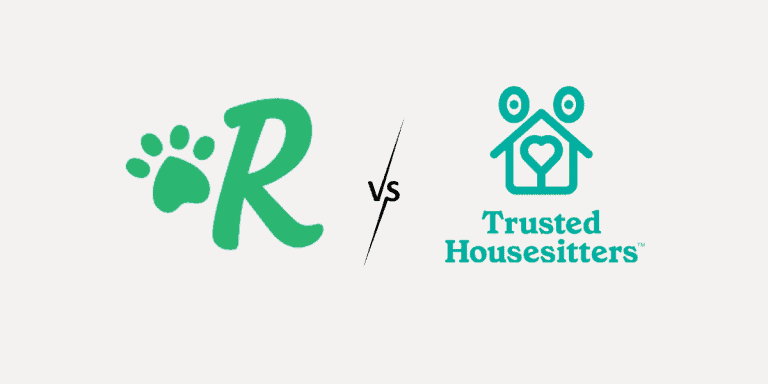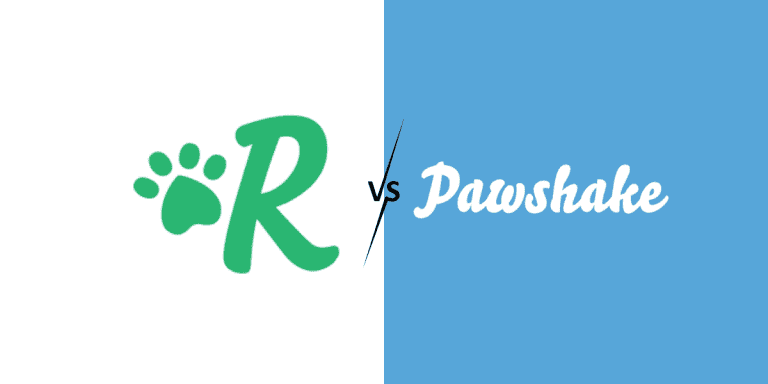How Much Should You Charge for Pet Sitting? A UK Guide

Nobody likes being ripped off. If you’re alive, you probably know the feeling of having overpaid for something that’s under-delivered. The chances are, you didn’t go back for seconds.
If we want our pet sitting business to survive and grow, we should know how to price our services in a way that’s fair value for both ourselves and our customers.
In this post, I’ll be looking at the factors you should think about when setting your prices and showing you how to come up with a structure that works for you and your customers.
There are circumstances where you may want to temporarily increase or reduce your rates, and I’ll cover that too.
Finally, I’ll talk about when you should think about increasing your rates and how to do it without alienating your clients.
Want to know more about the ins and outs of pet sitting in general? Check out this ultimate guide!
What Affects Pet Sitting Rates?
Setting the right price for your pet sitting services is a bit of a balancing act. If you price yourself too high you’ll struggle to get clients. If you set your rate too low then you’ll likely be inundated, but also missing out on fair value for your skills.
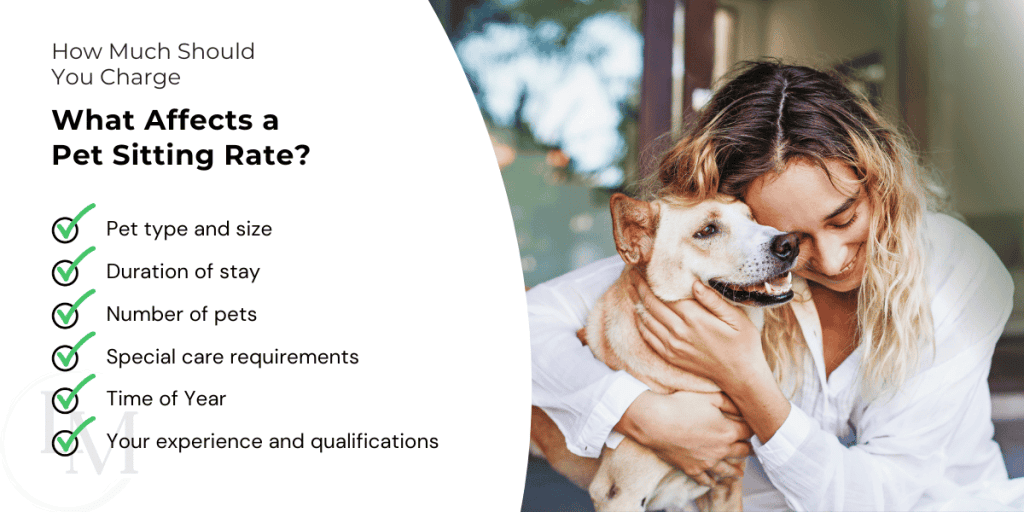
Here’s what you should think about when deciding how much you should charge:
Pet Type and Size
You know what they say – it’s horses for courses. A Great Dane needs different attention than a Chihuahua, and a cat has different needs than a rabbit (if you didn’t know, now you know).
Breed matters: Fitter dog breeds like border collies will require more exercise, which means more work for you. Consider charging more if you’ll be doing extra walks.
Species-specific care: Exotic pets like reptiles or birds may need specialised knowledge, which can command higher rates.
Duration of Stay
The length of a pet sitting job might change how you want to charge for your service.
Short visits: For quick drop-ins to feed a cat or walk a dog, you might charge an hourly rate.
Overnight stays: These usually command a higher flat rate, as you’re providing round-the-clock care and possibly house sitting as well.
Long-term assignments: For extended stays, consider offering a slight discount to incentivise bookings, but make sure it’s still worth your while.
Number of Pets
More pets mean more work, so your rates should reflect this.
Multi-pet households: Charge an additional fee for each extra pet. This could be a percentage of your base rate or a flat fee per additional animal.
Mixed species households: If you’re caring for both dogs and cats in the same home, factor in the different care requirements for each.
Special Care Requirements
Some pets need a little extra TLC, and your rates should account for this.
Medication administration: If you need to give pills, injections, or other treatments, charge extra for this service. It requires additional responsibility and time.
Senior or special needs pets: Older animals or those with health issues may need more frequent check-ins or specialised care. Adjust your rates accordingly.

Time of Year
Demand for pet sitting services fluctuates throughout the year, and your pricing can reflect this.
Holiday surcharges: During peak holiday periods like Christmas or summer holidays, you can charge a premium rate due to increased demand. If you’re using a platform like Rover, premium rates for holidays are figured out and added for you if you want to apply them.
Off-peak discounts: To encourage bookings during slower periods, consider offering slight discounts or promotions.
Your Experience and Qualifications
As you gain experience and qualifications, you can justify higher rates.
Certifications: If you’ve completed pet first aid courses or have professional pet care qualifications, highlight these to justify higher rates.
Years of experience: As you build up a solid reputation and track record, gradually increase your rates to reflect your expertise.
Average Pet Sitting Rates in the UK
Knowing the average going rates for pet sitters will help you set your own prices accordingly.
In this section about the UK average pet sitting rates.
Remember, these are just averages – your specific rates may vary based on your location, experience, and the factors we discussed earlier.
National Average for Dog Sitting
Dog sitting is one of the most common pet care services in the UK. Here’s what you can expect:
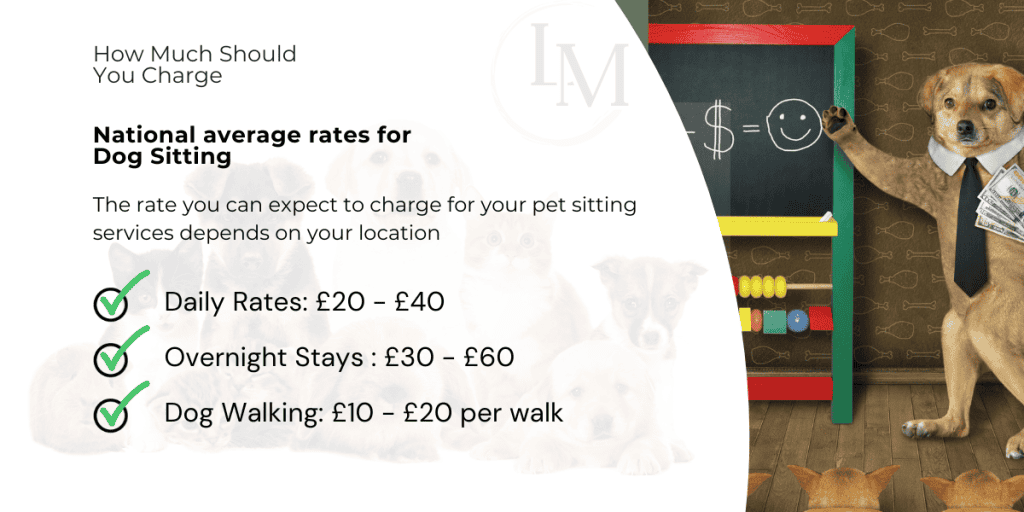
Daily rates: The average rate for dog sitting in the UK ranges from £20 to £30 per day. However, in London and other major cities, rates can go up to £40 or more per day.
Overnight stays: If you’re staying overnight at the client’s home, rates typically range from £30 to £60 per night.
Dog walking: As part of your sitting services, you might offer dog walking. The average rate for a one-hour dog walk is £10 to £20.
Typical Cat Sitting Prices
Cats are more independent than dogs and if the owner is away for a short time, it’s often enough to offer a drop in service rather than have the cat come and stay with you. Chances are, if you let them outside, they’d head home anyway.

Daily visits: For a 30-minute visit to feed, clean litter, and provide some companionship, the average rate is £10 to £15 per visit.
Multiple visits: If a client requests two visits per day, you might charge £18 to £25 for both visits combined.
Rates for Small Animals
Small pets like rabbits, guinea pigs, and hamsters generally require less time and effort, but still need attentive care:
Daily rates: For small animal care, including feeding, cleaning cages, and brief playtime, rates typically range from £8 to £12 per day.
Multiple pets: If caring for several small animals in one household, you might charge an additional £3 to £5 per extra animal.
Premium Rates for Exotic Pets
Exotic pets such as reptiles, birds, or unusual mammals often require specialised knowledge and care:
Daily rates: Due to the extra expertise required, rates for exotic pet sitting can range from £25 to £50 per day, depending on the species and care requirements.
Specialised care: For pets needing very specific environmental conditions or diets, rates can go even higher.

Overnight Stay Pricing
When you’re required to stay overnight in the client’s home, you’re providing round-the-clock care and security:
Weeknight rates: For a standard overnight stay (arriving in the evening and leaving the next morning), rates typically range from £40 to £60 per night.
Weekend rates: Weekend overnights often command a premium, with rates ranging from £50 to £75 per night.
Extended stays: For longer bookings (a week or more), you might offer a slight discount, perhaps £35 to £55 per night.
Hourly Rates for Drop-in Visits
For clients who need shorter, more flexible care options:
Standard rate: The average hourly rate for pet sitting in the UK ranges from £10 to £15 per hour.
Short visits: For quick 15-30 minute check-ins, you might charge a flat rate of £8 to £12 per visit.
These rates will vary depending on your location, so remember to do your own research.
In London and the South East, you might be able to charge 20-30% more than these averages. In more rural areas or smaller towns, rates might be slightly lower.
Setting Your Base Rate
So how do you actually figure out your base rate?
In this section, we’ll examine how to set a rate that factors in your costs, location, experience, time, and effort.
I’ll explain how and why to set a minimum booking fee, summarise the process, and calculate a figure.

Calculating Your Costs
Before you can set your rate, you need to understand your costs.
Transport expenses: If you’re travelling to clients’ homes, factor in your fuel costs or public transport fares. A good rule of thumb is to calculate your average daily travel cost.
Supplies: Think about any supplies you need to provide, such as poo bags, treats, or toys. While these might seem small, they can add up over time.
Insurance: Pet sitting insurance is a must-have. Factor in the daily cost of your insurance premium.
Marketing: Don’t forget to account for any costs associated with advertising your services, such as website hosting or business cards.
Researching Local Competition
You should know what other local sitters are charging so you can set competitive rates.
Local rates: Use online platforms or local pet sitting groups to research the going rates in your area. Your goal isn’t to undercut everyone, but to price competitively while reflecting your value.
Service offerings: Look at what services other sitters include in their base rate. This can help you decide what to include in yours.
Considering Your Experience Level
Your experience should be reflected in your rates:
Beginner rates: If you’re just starting out, it’s okay to charge rates at the lower end of the local average while you build up experience and references.
Expert rates: If you have years of experience or special qualifications, don’t be afraid to charge premium rates. Your expertise is valuable!
Factoring in Your Time and Effort
Remember, you’re not just charging for the time spent with the pets:
Admin time: Factor in time spent on booking, communication with clients, and travel.
Preparation time: Include time spent preparing for visits or stays.
Actual service time: This is the time spent directly caring for the pets.
Setting a Minimum Booking Fee
It’s important to ensure that even short bookings are worth your time:
Minimum visit fee: For drop-in visits, consider setting a minimum fee. For example, you might charge a minimum of £15, even if the visit is only 15 minutes.
Minimum booking period: For overnight stays, you might set a minimum booking of two nights to make it worth your while.
Putting It All Together
Now that you’ve considered all these factors, it’s time to set your base rate. Here’s a simple formula to get you started:
- Calculate your hourly rate: Add up your daily costs (including a portion of your monthly expenses) and the number of hours you want to work. Divide your desired daily income by the number of working hours. For example, if you want to earn £80 per day and work 8 hours, your base hourly rate would be £10.
- Set your daily rate: Multiply your hourly rate by the number of hours in a typical day of pet sitting. If a day involves 4 hours of active work, your daily rate might be £40.
- Adjust for your market: Look at your calculated rate in comparison to your local market research. Adjust up or down slightly to remain competitive while reflecting your unique value.
Your base rate is just a starting point. You’ll adjust this rate up or down based on specific job requirements, peak periods, or special circumstances.
Pro tip: Review and adjust your rates regularly. As you gain experience and your costs change, your rates should reflect this. A good rule of thumb is to review your pricing every 6-12 months.
Adjusting Your Rates for Different Services
So you know your base rate – brilliant!
But it’s good to know how, why and when to tweak it.
In this section I’ll talk about the different circumstances you’ll regularly encounter where you should think about adjusting your rate to match the service you’re providing.

Additional Fees for Multiple Pets
When caring for more than one pet, you’re taking on extra responsibility and work.
Here’s how to adjust your rates:
Per additional pet fee: A common approach is to charge 50% of your base rate for each additional pet. For example, if your base rate for one dog is £30 per day, you might charge £45 for two dogs.
Flat rate increase: Another method is to add a flat fee for each extra pet. This could be £5-£10 per additional pet, depending on the type of animal and care required.
Household cap: Consider setting a maximum fee for multi-pet households to remain competitive. For instance, you might cap your fee at four pets, even if you’re caring for more.
Pricing for Administering Medication
Giving medication requires extra care and responsibility.
Here’s how to price this service:
Per-medication fee: Charge an additional £2-£5 per medication administered. This accounts for the extra time and responsibility involved.
Complexity-based pricing: For more complex medical tasks, like insulin injections or wound care, you might charge £5-£10 extra per day.
Time-based surcharge: If medical care significantly increases your visit time, consider charging an additional 15-30 minutes at your hourly rate.
Extra Charges for House Sitting Duties
When you’re staying in a client’s home, you’re often expected to do more than just care for pets:
Plant watering: Add £2-£5 per day for basic plant care.
Light housekeeping: For tasks like taking out bins or basic tidying, add £5-£10 per day.
Rates for Long-Term Bookings
Offering a discount for longer bookings can encourage clients to book you for extended periods:
Weekly discount: Consider offering a 10-15% discount for bookings of 7 days or more.
Monthly rate: For very long-term bookings, you might offer a more significant discount, say 20-25% off your daily rate.
Loyalty pricing: For repeat clients booking long stays, you could offer an additional 5% off as a loyalty bonus.
Holiday and Weekend Surcharges
During peak periods, it’s standard practice to charge a bit extra:
Bank holiday surcharge: Add 20-50% to your standard rate for bank holidays.
Weekend rates: Consider a 10-20% surcharge for Friday and Saturday nights.
Peak season pricing: During busy periods like summer holidays or Christmas, you might implement a 15-25% surcharge on all bookings.
Early Morning or Late-Night Visit Fees
Visits outside standard hours often warrant a higher rate:
Unsocial hours fee: For visits before 7am or after 9pm, add a £5-£10 surcharge.
Middle-of-night visits: If a pet requires a check-in between 11pm and 6am, consider charging double your standard visit rate.
Raising Your Rates
As your pet sitting business grows and you gain more experience, there will come a time when you need to raise your rates. This can feel daunting, but it’s a natural part of running a successful business.

When to Increase Your Prices
Timing matters when it comes to raising your rates.
Here are some signs that it might be time to price your pet sitting services a little higher:
Annual review: Many businesses increase their prices yearly to keep up with inflation. Consider making this a regular part of your business strategy.
Increased demand: If you’re consistently booked up weeks in advance, it’s a good sign that your services are in high demand and could command a higher price.
New skills or certifications: If you’ve invested in additional training or certifications, you can justify higher rates based on your enhanced expertise.
Rising costs: If your business expenses have increased (e.g., higher fuel costs, insurance premiums), you may need to raise rates to maintain your profit margin.
Market changes: Keep an eye on local competitors. If the going rate for pet sitting in your area has increased, you should consider adjusting your prices accordingly.
How to Communicate Price Changes to Clients
Clear, professional communication is key when telling clients about rate increases:
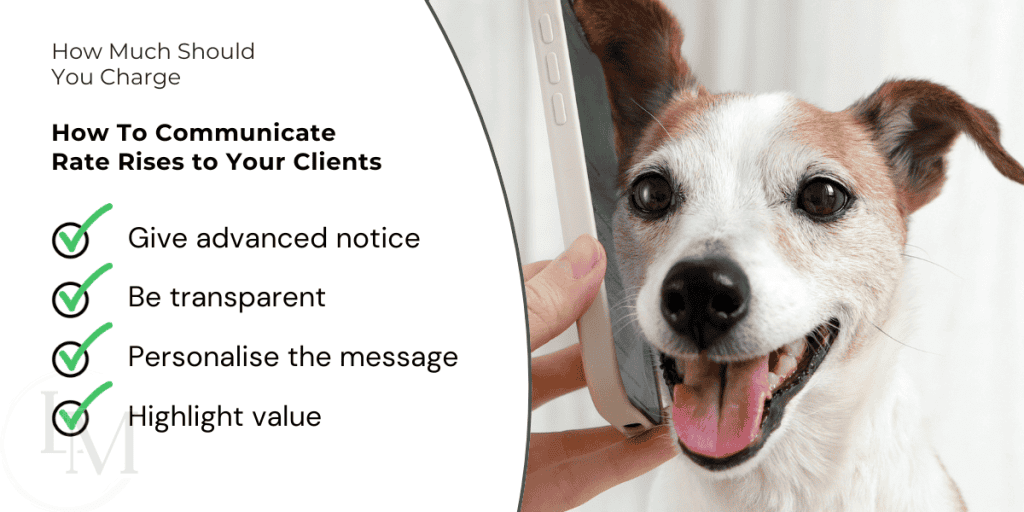
Give advance notice: Tell your clients about the price change at least one month in advance. This gives them time to adjust their budgets or make alternative arrangements if necessary.
Be transparent: Explain the reasons for the increase. Clients are more likely to understand if they know why it’s happening.
Personalise the message: For your regular clients, consider sending individual emails or having face-to-face conversations about the change.
Highlight value: Remind clients of the quality service you provide and any improvements or additional benefits you’ve introduced since your last price increase.
Offering Grandfathered Rates for Loyal Customers
Consider rewarding your long-term clients with special pricing:
Loyalty discount: Offer your most loyal clients a smaller increase or delay the increase for them. For example, “As a valued long-term client, your rate increase will be only 5% instead of the standard 10%.”
Extended notice period: Give your regular clients a longer notice period before the new rates apply to them. “New rates will apply from [Date] for new clients, and from [Later Date] for our existing clients.”
Rate lock period: Offer to lock in current rates for a set period if clients book in advance. “Book your pet sitting for the next six months now to lock in our current rates!”
Handling Client Reactions
Be prepared for a range of reactions when you announce a price increase:
Listen to concerns: If clients express worries about the new rates, listen empathetically and be open to discussion.
Be firm but flexible: Stand by your decision to increase rates, but be willing to work with valued clients to find a solution that works for both parties.
Conclusion: How to Price Pet Sitting Services
Figuring out how much to charge for your pet sitting services is pretty straightforward.
If you know the averages for your area, are able to factor in your time and experience and know how and when to adjust your rates, you’re setting yourself up for success.
When done right, your pricing strategy will offer fair value for your services, without selling yourself short.
Nobody likes being ripped off. If you price yourself too high, your customers are going to feel like they’re getting a bad deal.
Be careful not to rip yourself off too – if you price yourself too low, you’ll feel overworked, overwhelmed and underpaid.

